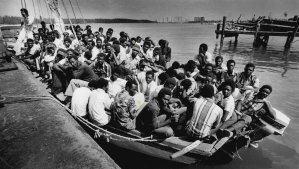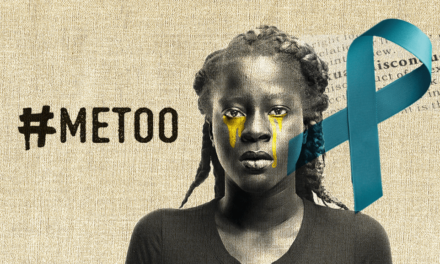By Jacqueline Charles,
Miami Herald via The Associated Press
They arrived over 50 years ago, fleeing dictatorship and death. Along the treacherous, three-week ocean journey, the seafaring Haitian asylum seekers traded their shoes for food and water in Cuba, and were briefly jailed in the Bahamas before being asked their final destination.
“Miami,” they all said.
When their leaking, 56-foot wooden sailboat finally made landfall 40 miles north of Miami in Pompano Beach on Dec. 12, 1972, there was no family or Haitian community to welcome them, or protesters lining the shorelines demanding their freedom.
“They arrested us, put us in jail,” recalled Marie Bernard, who was among the 65 passengers, including two children, aboard the Saint Sauveur, the first documented boat of Haitian refugees to arrive in South Florida.
“They said there were others who would be coming behind us and they didn’t want them to ask why they were detained and we were not,” she said. “So we accepted to be jailed.”
Bernard left Haiti on Nov. 23, 1972, after her first husband, an army officer, was killed by the Duvalier regime. Fear of a similar fate led her to board a stolen wooden boat and set sail for Florida.
Ultimately the Haitian migrants banded together with a group of Black Baptist ministers, Catholic priests and Haitian exiles in New York and began challenging U.S. immigration and detention policies. In the process, they also gave birth to a new South Florida community of mostly Black, Creole-speaking refugees with French-sounding surnames.
When the U.S. Immigration and Naturalization Service denied Bernard’s claim for political asylum, she became a plaintiff in the first challenge by Haitian “boat people” of U.S. government policy.
Then known as Marie Jean Pierre, she and 215 other Haitians who had fled to the U.S. on boats between 1972 and 1973 sued the U.S. government in federal court. The class-action lawsuit, Pierre v. U.S., was led by renowned civil rights and immigration attorney Ira Gollobin. Though the group’s claim of racial bias and unequal treatment of Haitian migrants wasn’t successful, it set the tone for what was to come.
In 1980, after 5,000 Haitian boat people had been denied political asylum, one discrimination case — Haitian Refugee Center v. Civiletti — claiming that the U.S. government practiced “blatant racism,” was successful. In addition, pressure on the U.S. by the Washington, D.C.-based Haitian Refugee Project’s Fritz Longchamp, who later became a foreign minister of Haiti, and Michael Posner, who later became an assistant secretary of state, led the Carter administration to establish the Cuban-Haitian Entrant Act of 1980.
“Those of us, old-timers, we worked hard in the community. They called us crazy because we were protesting everywhere in the streets,” said Bernard, who was able to adjust her immigration status under the new law and become a legal permanent resident, which allowed her to reunite with the two children she had left behind in Haiti.
Other immigrants who were able to obtain permanent legal status “would say, ‘Where did those Haitians, who have come to dirty the image of people here, come from?’ But we held our heads high, even up until now,” Bernard said. “We respected the law, we lived our lives. I am going to have 50 years here in this country, and I have never had a problem.”
It wouldn’t have been possible, she said, had it not been for the legal challenges, the protests and those early champions of Haitian rights, like the Rev. Jacques Mompremier — whose Friendship Missionary Baptist Church in Miami served as a temporary home for her and the other first refugees — and the Rev. Gérard Jean-Juste, a Catholic priest.
At 79, Bernard has lived to welcome three generations of family. Her five children have become homeowners, medical professionals and U.S. Army and Air Force veterans, as well as parents and grandparents.
That pioneering legacy, along with so many other moments both triumphant and sad, is being commemorated in what South Florida’s Haitian community is calling the “December 12 Project: The day we became boat people.”
“They represent all that is strong and resilient in our culture,” said Sandy Dorsainvil, who is helping to organize a gathering at 6 p.m. Dec. 26 at the Little Haiti Cultural Center. “Their victory over the cold sea shows our children every day that they can do anything.”
The year-long commemoration will trace the Haitian-American community’s rise in South Florida through reflections, storytelling, music, poetry, panel discussions and other activities.
HAITIANS STILL TAKING TO THE SEA IN DEADLY VOYAGES
“Those who have been allowed to stay in the U.S. have made tremendous strides during the past 50 years,” said Marleine Bastien, a Haitian community and immigration activist who last month became the second Haitian American and first woman of Haitian descent elected to the Miami-Dade County Commission.
Those strides can be seen in the number of Haitian Americans who currently hold elected offices, serve as the heads of private and professional organizations, and have made a name for themselves in the fields of education and medicine.
But the going was difficult for those first arrivals. While the first group was welcomed by Black pastors and other religious leaders, the subsequent waves got a lukewarm reception, labeled “boat people” and encountering a U.S. immigration system bent on sending them back.
As their numbers continued to rise, their presence fueled racial and ethnic tensions. Then in the early 1980s, at the height of the AIDS epidemic, the U.S. Centers for Disease Control and Prevention identified Haitians as being among the four risk groups for the new disease. In March 1983, the CDC said the highest number of AIDS cases were among homosexuals, hemophiliacs, heroine users and Haitians. They became known as the “Four-H Club.”
“In spite of that, you see a sense of soldiering on, you see people working to ensure that they are perceived as human beings, human beings who are worthy of safety, worthy of being valued, worthy of dignity,” said Gepsie Metellus, the executive director of Sant La Haitian Neighborhood Center, a community organization in North Miami.
Bastien said the journey of the first Haitian refugees and the legal battles they waged to stay in the United States, while worthy of celebration, are also reminders of how little has changed. Five decades later, Haitians are still taking to the sea in deadly voyages, only to be detained and deported back.
Instead of fleeing dictatorship, they are being pushed by social upheaval, gang violence, kidnappings and political turmoil, all made worse by last year’s assassination of Haitian President Jovenel Moïse.
“President Biden has deported 24,000 people at a time when Haiti is reeling under the worst political conditions in its recent history,” Bastien said. “People are basically refugees in their own homeland. They cannot live in their own homes; women have to protect their little girls so that they are not gang raped, girls as young as 5 years old.
“This is a country at war,” she added. “This bleak, sad history clearly tells us that U.S. policy toward Haiti must change; we must address the root causes of this risky, oftentimes deadly migration to create safe conditions for Haitians to stay home.”
Metellus said she hopes the Haitian community’s story in South Florida can encourage change back home. At the very least, she said, she hopes that the sharing of stories will inspire younger generations of Haitian Americans.
“We are a relatively strong Haitian-American community, in spite of everything,” Metellus said. “The story for me is of our triumphant spirit.”
Help us Continue to tell OUR Story and join the AFRO family as a member –subscribers are now members! Join here!
The post Over 50 years of Haitian migration to South Florida appeared first on AFRO American Newspapers .











